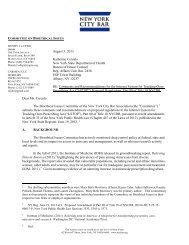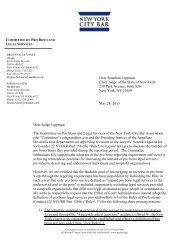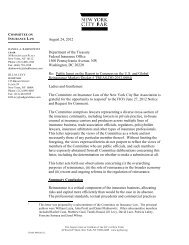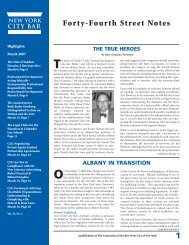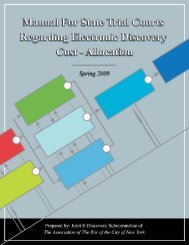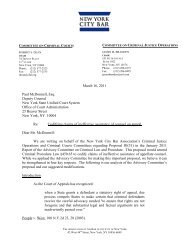2007 Issue 1 - New York City Bar Association
2007 Issue 1 - New York City Bar Association
2007 Issue 1 - New York City Bar Association
You also want an ePaper? Increase the reach of your titles
YUMPU automatically turns print PDFs into web optimized ePapers that Google loves.
J U D I C I A L S E L E C T I O N S Y S T E M I N N E W Y O R K S T A T E<br />
been designated for nomination or nominated, as the case may be. The<br />
biographical entry shall also reflect whether the candidate was reported<br />
out as “most qualified” for a vacancy, “highly qualified” (in the case of<br />
an incumbent) or “unqualified.”<br />
III. DIVERSITY CONSIDERATIONS REGARDING BOTH<br />
APPOINTIVE AND ELECTIVE JUDICIAL SELECTION SYSTEMS 61<br />
The Task Force is committed to a judicial selection system that effectively<br />
promotes a diverse judiciary. A diverse judiciary is necessary to ensure<br />
that our populations are appropriately represented; to ensure that a<br />
broad array of views and experiences are brought to the bench; to regain<br />
the public’s confidence in the judiciary, and to restore the judicial system’s<br />
credibility in the public’s eyes.<br />
After reviewing a large variety of data, empirical studies and articles<br />
generally regarding minorities serving on <strong>New</strong> <strong>York</strong> State’s judiciary, the<br />
Task Force realized that it was unable to conclude on the statewide level<br />
whether one of the two systems—appointive or elective—better promotes<br />
diversity. Some of the difficulties the Task Force encountered were the<br />
following:<br />
• Although statistics on the composition of the population in<br />
the twelve judicial districts are generally available, there is a<br />
lack of reliable statistics on the diversity of the actual voting<br />
population as well as the diversity of the practicing lawyer’s—<br />
and thus potential justices’—population. In addition, sometimes<br />
the available information does not correspond to the judicial<br />
district distributions.<br />
• Where diverse qualifications commissions are not in place<br />
statewide to screen the candidates before the appointing<br />
authority’s final selection, statistics on the minority justices selected<br />
through an appointive system do not demonstrate the efficacy<br />
of the appointive system to ensure diversity.<br />
• Available statistics on the percentage of minority justices on<br />
the bench (when compared to the percentage of minorities in<br />
the underlying population) reveal significantly different results<br />
among the various judicial districts, thus rendering any conclusion<br />
on the statewide level very difficult.<br />
61. For purposes of this Report, “diversity” is defined on the basis of race, ethnicity, gender,<br />
religion and sexual preference.<br />
2 0 0 7 V O L. 6 2 , N O. 1<br />
115



